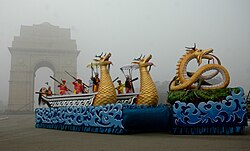| Yumjao Leima | |
|---|---|
All time reigning queen mother Goddess of house, household, royalty, rule and power | |
| Member of Lairembis | |
 | |
| Other names |
|
| Affiliation | Meitei mythology (Manipuri mythology) and Meitei religion (Sanamahism) |
| Major cult center | Kangla and Sana Konung |
| Abodes | houses |
| Texts | Puyas |
| Gender | Female |
| Region | Manipur |
| Ethnic group | Meitei ethnicity |
| Festivals | Lai Haraoba |
| Genealogy | |
| Children | All the Meitei Kings (in spiritual sense) |
| Equivalents | |
| Chinese | Queen Mother of the West |
| Part of a series on |
| Meitei mythology |
|---|
 |
| Part of a series on |
| Sanamahism |
|---|
 |
Yumjao Leima (Old Manipuri : Yumchao Leima) or Yumjao Lairembi (Old Manipuri : Yumchao Lailempi) or Yumjao Lairemma (Old Manipuri : Yumchao Lailemma) is the mother goddess of house, household, royalty, rule and power in Meitei mythology and religion. [1] [2] [3] [4] She is designated as the all time ruling Queen Mother. [5] Legend says she assumes a human form in white clothes and blesses kings. [6] She is one of the divine incarnations of Leimarel Sidabi. [7]
